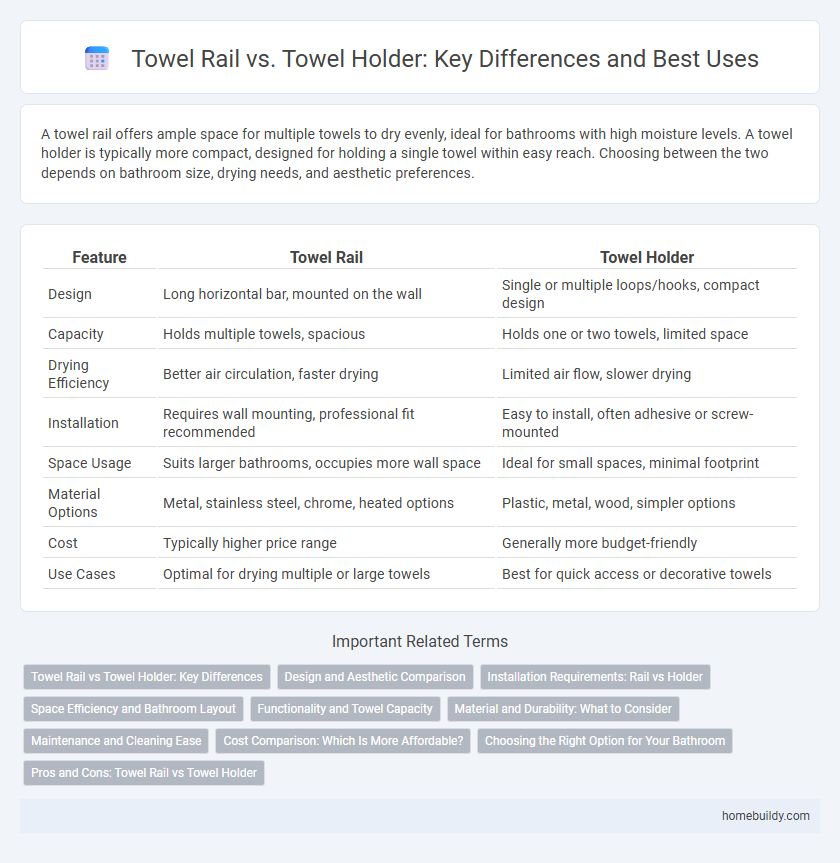A towel rail offers ample space for multiple towels to dry evenly, ideal for bathrooms with high moisture levels. A towel holder is typically more compact, designed for holding a single towel within easy reach. Choosing between the two depends on bathroom size, drying needs, and aesthetic preferences.
Table of Comparison
| Feature | Towel Rail | Towel Holder |
|---|---|---|
| Design | Long horizontal bar, mounted on the wall | Single or multiple loops/hooks, compact design |
| Capacity | Holds multiple towels, spacious | Holds one or two towels, limited space |
| Drying Efficiency | Better air circulation, faster drying | Limited air flow, slower drying |
| Installation | Requires wall mounting, professional fit recommended | Easy to install, often adhesive or screw-mounted |
| Space Usage | Suits larger bathrooms, occupies more wall space | Ideal for small spaces, minimal footprint |
| Material Options | Metal, stainless steel, chrome, heated options | Plastic, metal, wood, simpler options |
| Cost | Typically higher price range | Generally more budget-friendly |
| Use Cases | Optimal for drying multiple or large towels | Best for quick access or decorative towels |
Towel Rail vs Towel Holder: Key Differences
A towel rail is designed to hang towels horizontally, providing ample space for full towel drying and preventing dampness, while a towel holder typically features a ring or hook for smaller towels or quick access. Towel rails often come in various sizes and materials, including heated options that enhance drying efficiency and bathroom warmth, unlike basic towel holders. Choosing between a towel rail and holder depends on bathroom size, towel drying needs, and aesthetic preferences.
Design and Aesthetic Comparison
Towel rails offer sleek, elongated designs that enhance modern bathroom aesthetics while providing ample space for multiple towels to dry evenly. In contrast, towel holders often feature compact, minimalist shapes that suit smaller spaces but may compromise on drying capacity and visual impact. The choice between towel rail and holder significantly influences bathroom decor, with rails contributing a streamlined, contemporary look and holders delivering subtle, functional accents.
Installation Requirements: Rail vs Holder
Towel rails require secure wall mounting with robust anchors to support the weight of wet towels and ensure stability. Towel holders generally have simpler installation needs, often using adhesive backing or lighter screws, suitable for holding a single towel or robe. Proper installation of towel rails ensures durability and prevents damage to walls, while towel holders prioritize ease of setup and flexibility in placement.
Space Efficiency and Bathroom Layout
Towel rails provide superior space efficiency compared to towel holders by offering extended horizontal bars that can accommodate multiple towels simultaneously, making them ideal for larger or shared bathrooms. Their elongated design integrates seamlessly into bathroom layouts, often mounted on walls or near showers, optimizing vertical space without cluttering countertops. In contrast, towel holders typically support a single towel and require less installation space but may fall short in maximizing storage flexibility within compact or multifunctional bathroom environments.
Functionality and Towel Capacity
Towel rails offer greater towel capacity by allowing multiple towels to hang and dry simultaneously, enhancing airflow and reducing dampness compared to towel holders. Unlike towel holders, which typically accommodate one towel, towel rails are designed for efficient drying and organization in bathrooms. Their elongated structure maximizes space utility, providing both functionality and convenience.
Material and Durability: What to Consider
Towel rails are typically made from stainless steel, aluminum, or chrome-plated metal, offering superior durability and resistance to rust and corrosion compared to towel holders, which often use plastic or lightweight metal. The choice of material directly impacts the lifespan, with metal towel rails providing stable heat conduction for quicker drying and longer-lasting performance. Selecting high-quality materials ensures both functional strength and a sleek appearance, crucial for bathroom environments prone to moisture.
Maintenance and Cleaning Ease
Towel rails typically offer easier maintenance and cleaning due to their elevated design, preventing water accumulation and reducing mold growth. Towel holders, especially those with intricate designs, may trap dust and moisture, making thorough cleaning more challenging. Choosing a towel rail can enhance hygiene and simplify regular upkeep in bathrooms.
Cost Comparison: Which Is More Affordable?
Towel rails generally cost more upfront than towel holders due to their larger size and heating functionality, with prices ranging from $50 to $300 compared to $10 to $50 for basic towel holders. Installation costs for towel rails tend to be higher, especially for heated models requiring electrical connections, while towel holders typically involve simple mounting hardware and lower labor costs. For budget-conscious buyers, towel holders offer a more affordable option, though towel rails provide added benefits like faster drying and enhanced bathroom warmth, potentially increasing long-term value.
Choosing the Right Option for Your Bathroom
Towel rails provide ample space for drying multiple towels and help reduce moisture build-up, making them ideal for larger bathrooms or those with higher humidity levels. Towel holders, typically smaller and more compact, are better suited for limited spaces or minimalist bathroom designs where only one or two towels need storage. Selecting between a towel rail and a towel holder depends on your bathroom size, drying needs, and overall aesthetic preferences to ensure functionality and style are balanced.
Pros and Cons: Towel Rail vs Towel Holder
Towel rails provide ample space for drying multiple towels simultaneously, promoting better air circulation and faster drying, whereas towel holders are more compact, saving space but limiting towel capacity. Towel rails require more installation space and may be less suitable for small bathrooms, while towel holders offer flexibility in placement and require less wall area. Choosing between them depends on bathroom size, user convenience, and drying efficiency needs.
Towel rail vs Towel holder Infographic

 homebuildy.com
homebuildy.com